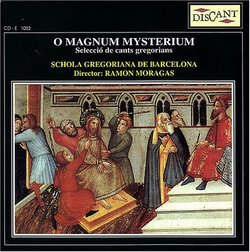| All Artists: Gregorian Chant, Beneventan Chant Title: O Magnum Mysterium Members Wishing: 1 Total Copies: 0 Label: Discant Release Date: 3/29/2005 Genre: Classical Styles: Opera & Classical Vocal, Historical Periods, Early Music Number of Discs: 1 SwapaCD Credits: 1 UPC: 675754825225 |
Search - Gregorian Chant, Beneventan Chant :: O Magnum Mysterium
 | Gregorian Chant, Beneventan Chant O Magnum Mysterium Genre: Classical
|
Larger Image |
CD Details |
CD ReviewsHistorically accurate recording hints at Gregorian Chant's t Eddie Konczal | 03/23/2007 (3 out of 5 stars) "The continued popularity of Gregorian Chant (or plainchant) owes much to the 1994 re-release of "Chant" by the Benedictine Monks of Santo Domingo de Silos. But its enduring legacy dates back to the dawn of the 9th century and the codification of church-approved plainchants under the aegis of Charlemagne - perhaps even earlier, if their attributed authorship by Pope Gregory the Great around the year 600 is genuine. These monophonic chants, simple and serene, possess a mysterious and otherworldly beauty, which extends their appeal far beyond their intended purpose as worship music.
"O Magnum Mysterium" presents a collection of chant from Catalan manuscripts of the 9th through 12th centuries. Catalan notation could not indicate variations in pitch, and eventually was supplanted by more versatile notational methods. Though the adherence to Catalan notation enhances the historical accuracy of this recording, it also places melodic restraints upon music already lacking in harmony or rhythmic variation. The individual chants are satisfying enough, but there isn't enough diversity in the collection as a whole to compensate for the limitations imposed by the original notation. The performances by Schola Gregoriana de Barcelona are fine throughout; one would like to hear them tackle something with greater variety in pitch. The recording effectively captures the natural church echo so crucial to plainchant's hypnotic appeal. While "O Magnum Mysterium" might not generate as much enthusiasm for Gregorian chant as "Chant" did, it should still instill feelings of peace and tranquility in the casual listener. Scholars of early music will better appreciate this disc for its rigorous historical approach. " |

 Track Listings (19) - Disc #1
Track Listings (19) - Disc #1